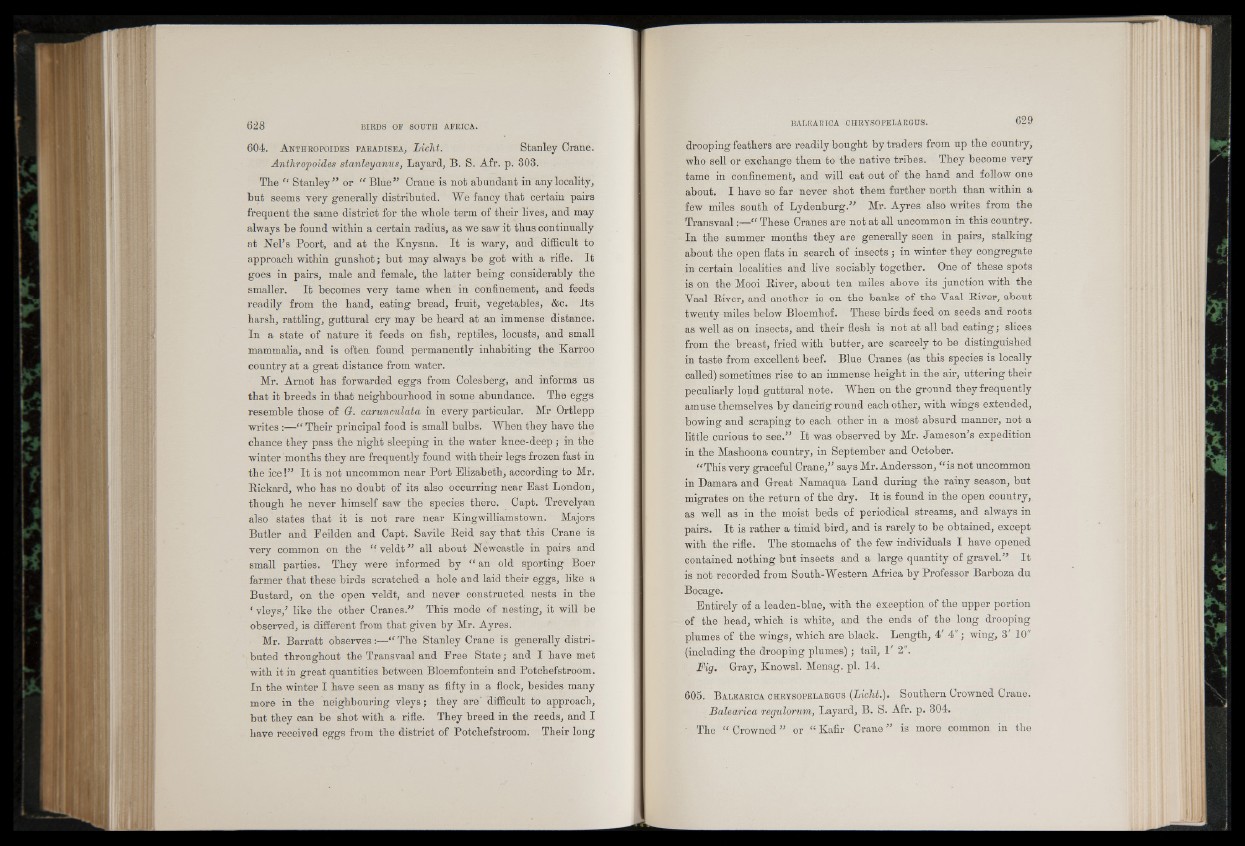
604. A n t h r o po id is paradisea, Licht. Stanley Crane.
Anthropoides stanleyanus, Layard, B. S. Afr. p. 808.
The “ Stanley” or “ Blue” Crane is not abundant in any locality,
but seems very generally distributed. We fancy that certain pairs
frequent the same district for the whole term of their lives, and may
always be found within a certain radius, as we saw it thus continually
at Nel’s Poort, and at the Knysna. It is wary, and difficult to
approach within gunshot; but may always be got with a rifle. It
goes in pairs, male and female, the latter being considerably the
smaller. It becomes very tame when in confinement, and feeds
readily from the hand, eating bread, fruit, vegetables, &c. Its
harsh, rattling, guttural cry may be heard at an immense distance.
In a state of nature it feeds on fish, reptiles, locusts, and small
mammalia, and is often found permanently inhabiting the Karroo
country at a great distance from water.
Mr. Araot has forwarded eggs from Colesberg, and informs us
that it breeds in that neighbourhood in some abundance. The eggs
resemble those of G. carunculata in every particular. Mr Ortlepp
writes :—“ Their principal food is small bulbs. When they have the
chance they pass the night sleeping in the water knee-deep; in the
winter months they are frequently found with their legs frozen fast in
the ice!” It is not uncommon near Port Elizabeth, according to Mr.
Rickard, tvho has no doubt of its also occurring near East London,
though he never himself saw the species thero. Capt. Trevelyan
also states that it is not rare near Kingwilliamstown. Majors
Butler and Eeilden and Capt. Savile Reid say that this Crane is
very common on the “ veldt” all about Newcastle in pairs and
small parties. They were informed by “ an old sporting Boer
farmer that these birds scratched a hole and laid their eggs, like a
Bustard, on the open veldt, and never constructed nests in the
‘ vleys/ like the other Cranes.” This mode of nesting, it will be
observed, is different from that given by Mr. Ayres.
Mr. Barratt observes:—“ The Stanley Crane is generally distributed
throughout the Transvaal and Free State; and I have met
with it in great quantities between Bloemfontein and Potchefstroom.
In the winter I have seen as many as fifty in a flock, besides many
more in the neighbouring vleys; they are' difficult to approach,
but they can be shot with a rifle. They breed in the reeds, and I
have received eggs from the district of Potchefstroom. Their long
drooping feathers are readily bought by traders from up the country,
who sell or exchange them to the native tribes. They become very
tame in confinement, and will eat out of the hand and follow one
about. I have so far never shot them further north than within a
few miles south of Lydenburg.” Mr. Ayres also writes from the
Transvaal:—“ These Cranes are not at all uncommon in this country.
In the summer months they are generally seen in pairs, stalking
about the open flats in search of insects ; in winter they congregate
in certain localities and live sociably together. One of these spots
is on the Mooi River, about ten miles above its junction with the
Vaal River, and another is on the banks of the Vaal River, about
twenty miles below Bloemhof. These birds feed on seeds and roots
as well as on insects, and their flesh is not at all bad eating; slices
from the breast, fried with butter, are scarcely to be distinguished
in taste from excellent beef. Blue Cranes (as this species is locally
called) sometimes rise to an immense height in the air, uttering their
peculiarly loud guttural note. When on the ground they frequently
amuse themselves by dancing round each other, with wings extended,
bowing and scraping to each other in a most absurd manner, not a
little curious to see.” It was observed by Mr. Jameson’s expedition
in the Mashoona country, in September and October.
“ This very graceful Crane,” says Mr. Andersson, “ is not uncommon
in Damara and Great Namaqua Land during the rainy season, but
migrates on the return of the dry. It is found in the open country,
as well as in the moist beds of periodical streams, and always in
pairs. It is rather a timid bird, and is rarely to be obtained, except
with the rifle. The stomachs of the few individuals I have opened
contained nothing but insects and a large quantity of gravel.” It
is not recorded from South-Western Africa by Professor Barboza du
Bocage.
Entirely of a leaden-blue, with the exception of the upper portion
of the head, which is white, and the ends of the long drooping
plumes of the wings, which are black. Length, 4' 4"; wing, 3' 10"
(including the drooping plumes); tail, 1' 2".
Fig. Gray, Knowsl. Menag. pi. 14.
605. B alearica chrysopelargus {Licht.). Southern Crowned Crane.
Balea/rica regulorum, Layard, B. S. Afr. p. 304.
■ The “ Crowned ” or « Kafir Crane ” is more common in the